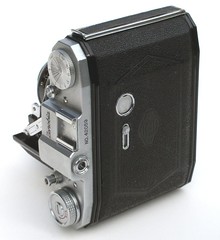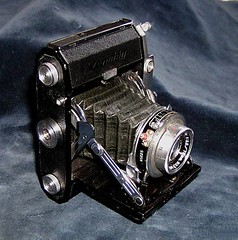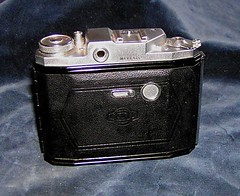Zenobia
The Zenobia (ゼノビア) is a series of Japanese 4.5×6 folders, successors to the Waltax. They were made from 1952 to 1957 by Daiichi Kōgaku, later Zenobia Kōgaku; and they were distributed by Hattori Tokei-ten at least until 1955. All the Zenobia models have a body copied from the Ikonta A and inherited from the Waltax.
Two companies sold modified and rebadged Zenobia cameras: Union Kōgaku offered the Union Semi, also called Union C-II, in 1953–4 and Walz the Walcon or Walcon Semi in 1954–5. In both cases the lens and shutter are different and there are other minor changes.
Contents
Viewfinder models
The Zenobia C and P

|
| Early Zenobia C I. image by Hillary Stein (Image rights) |
The Zenobia C and Zenobia P are continuations of the Waltax Senior, without double-exposure prevention. According to Kokusan kamera no rekishi, both appear in the Japanese camera announcements column of the January 1952 issue of Asahi Camera. The C has a synchronized D.O.C.–Rapid shutter with B, 1–500 speeds, the P I has a synchronized NKS shutter with B, 1–200 speeds and the P II is the same as the P I with a self-timer. The D.O.C.-Rapid is a copy of the Compur and the NKS is a copy of the Prontor, so it is possible that "C" stands for Compur and "P" for Prontor, but this is only a guess. It is the only appearance of the Zenobia P mentioned by Kokusan kamera no rekishi. A Zenobia with NKK shutter to 1/200 has been reported to exist[1], but no picture has been observed yet.
Shortly afterwards in 1952, the Zenobia C I and C II were advertised together[2]. They are explicitly mentioned as an improvement of the Waltax. The lens is a four-element Tessar-type coated Hesper 75mm f:3.5. (Many people seem to believe that the Hesper has three elements and the later Neo-Hesper four, but the advertisements clearly state otherwise.) The C I is the new name of the C and it is offered for ¥14,000[3] with a D.O.C.-Rapid B, 1–500 shutter (advertised as a Compur-Rapid copy), synchronized with an ASA bayonet connector. The C II is offered for ¥15,000 with a Seikosha-Rapid shutter having similar specifications.
In 1953, both versions were still offered[4], respectively for ¥14,000 and ¥16,000, together with the H II and R (see below). In 1954 only the C I was still advertised[5] for ¥13,000, together with the R I and R II. The shutter name has changed to Daiichi-Rapid.
Description of the Zenobia C
  
|
| Zenobia C I with D.O.C.-Rapid shutter and Hesper lens. images by Terry Hardy (Image rights) |

|
| Late Zenobia C I with EP engraving. image by Don Artz (Image rights) |
The Zenobia C is the most common model, especially in the C I version. The body, inherited from the Waltax, is originally a copy of the Ikonta 4.5×6.
The viewfinder is built in a top housing, with an accessory shoe, the advance knob on the left and a rotating depth-of-field scale on the right. The folding bed opening button is on the right and the shutter release on the left. The top housing is exactly the same as that of the Waltax Senior, except that the double-exposure prevention mechanism has disappeared. Even the shape of the knobs and buttons is the same. The advance knob is engraved with a black arrow to indicate the advance direction. One example has been observed[6] with an EP engraving ( for Exchange Post), meaning that it was sold in a PX shop of the US armed forces.
The back has one red window at the top, protected by a sliding cover. The bottom plate supports a tripod screw on the center and decorative knobs at both ends.
All the "Waltax" and "Okako" markings present on the Waltax have disappeared. There is a Zenobia marking engraved above the top housing in front of the accessory shoe and embossed in the front leather (at least usually, but this is absent on some examples, whose leather covering may have been changed). A DOC logo is embossed in the back leather. The folding struts are unmarked, and the serial number is now engraved in the back of the top housing. On the back opening there is a small piece of leather embossed MADE IN JAPAN.
Evolution of the Zenobia C

| |

| |
| Early Zenobia C I on the right (Hesper lens, D.O.C.-Rapid shutter, ASA synch) and late Zenobia C I on the left (Neo-Hesper lens, Daiichi-Rapid shutter, PC synch). images by Don Artz (Image rights) | |
The shutter of the C I is first a D.O.C.–Rapid with B, 1–500 speeds and later a Daiichi-Rapid of the same specifications. In the advertisements, the name change occurs between 1953 and 1954. The shutter of the C II is a Seikosha-Rapid giving the same speeds. All the shutters are synchronized. Among the shutters observed, all the D.O.C.-Rapid, all the Seikosha-Rapid and some examples of the Daiichi-Rapid (presumably early ones) have an ASA bayonet connector while other examples of the Daiichi-Rapid (presumably late ones) have a PC socket.
The lens is first a Hesper 75mm f:3.5 (marked Hesper Anastigmat 1:3.5 F=7.5cm No.xxxxx) and later a Neo-Hesper 75mm f:3.5 (marked Daiichi Opt. Neo-Hesper 1:3.5/75mm. No.xxxxx). Both are four-element Tessar-type lenses with front-cell focusing. The aperture is set from 3.5 to 22 by an index on top of the shutter housing. In the advertisements, the switch from Hesper to Neo-Hesper occurs between 1954 and 1955.
Minor changes were made to the body during the production. The late examples have a less rounded top housing, a slightly altered lens standard and a heavier tripod mount.
The Zenobia H and M
The Zenobia H switches from front-cell to unit focusing. The "H" probably stands for Helical.[7] It is advertised in March 1953[8] as the H II with the Seikosha-Rapid shutter, together with the C I, C II and R. The lens is the same Hesper 75mm f:3.5, and no price is given. Kokusan kamera no rekishi also mentions an H I with the D.O.C.-Rapid shutter. All the advertisements and magazine columns cited are from March 1953, and no example has been observed yet. It is unsure if this version was ever sold; anyway its life was very brief.
According to Kokusan kamera no rekishi, a Zenobia M was announced in 1955 with a three-element Hesper 75/3.5 lens and a Seikosha-Rapid shutter, but it was never sold.
Rangefinder models
The Zenobia R
  
|
| Zenobia R I, Daiichi-Rapid shutter, Neo-Hesper lens no.11014x, ASA synch. images by Al Reiswig (Image rights) |
The Zenobia R is like the Zenobia C with an uncoupled rangefinder, combined with the viewfinder. The "R" certainly stands for Rangefinder. The top housing is extended to the right to cover the additional rangefinder window. In place of the rotating depth-of-field scale, there is a lever positioned under the right thumb to set the rangefinder distance. The opening button for the folding bed has moved from the top housing to the front of the body, beside the Zenobia marking. The top engraving is now Zenobia R.
The R was advertised in 1952[9] as a new product, with the Seikosha-Rapid B, 1–500 synchronized shutter and the Hesper 75mm f:3.5 lens announced as being hard coated on all its elements. It is advertised again in 1953[10] for ¥19,000, appearing together with the viewfinder models and the Zenobiaflex.
In 1954, it was advertised[11] as R I with the Daiichi-Rapid shutter for ¥16,500 and R II with the Seikosha-Rapid for ¥18,500, together with the C I. It is unknown if the R I exists with the older D.O.C.–Rapid shutter name. Most have an ASA bayonet synch connector, but the R I also exists with a PC synch connector.[12] Many examples of the Zenobia R have been observed with the Neo-Hesper lens.
The Zenobia SR
The Super Zenobia SR I, advertised in 1955[13], has a coupled rangefinder with front-cell focusing, a Neo-Hesper 75mm f:3.5 lens and the Daiichi-Rapid B, 1–500 synchronized shutter. "SR" certainly stands for Super Rangefinder. Its appearance is fairly similar to the Zenobia R, but in place of the distance setting lever there is a knob whose usage is unknown. The opening button for the folding bed is at the same place on the front of the body.
The later Zenobia SR was advertised in 1956[14] for ¥14,000. The company name has now changed to Zenobia Kōgaku. The SR is intermittently called Super Zenobia SR and is quite similar to the SR I. The shutter is a Copal-MX with B, 1–300 speeds and the knob on the right of the top housing is replaced by a piece of leather. The opening button for the folding bed is now under the camera, unlike the SR I. There is a focusing tab and a small cover in front of the shutter certainly hiding the coupling cam. The top engraving is simply Zenobia and the serial number is engraved in the accessory shoe. The lens is engraved Zenobia Opt. instead of Daiichi Opt., reflecting the company's name change.
The last advertisements mentioned by Kokusan kamera no rekishi are dated 1957.
Notes
- ↑ In posts dated Sep 10 and Sep 11, 2003 (archived) at the Classic Camera Repair Forum.
- ↑ Advertisement for the Zenobia C I and C II, published in the Apr 1952 issue of Asahi Camera, reproduced in Kokusan kamera no rekishi, item 570.
- ↑ All the prices mentioned include a case.
- ↑ Advertisement for the Zenobia H II, C I, C II, R and Zenobiaflex, published in the Mar 1953 issue of Asahi Camera, reproduced in Kokusan kamera no rekishi, item 573.
- ↑ Advertisement for the Zenobia R I, R II, C I and Zenobiaflex, published in the Apr 1954 issue of Asahi Camera, reproduced in Kokusan kamera no rekishi, item 572.
- ↑ In an online auction.
- ↑ Unit focusing is in Japanese herikaru, i.e. "helical".
- ↑ March 1953 advertisement cited above.
- ↑ Advertisement for the Zenobia R, published in the June 1952 issue of Asahi Camera, reproduced in Kokusan kamera no rekishi, item 571.
- ↑ March 1953 advertisement cited above.
- ↑ April 1954 advertisement cited above.
- ↑ See the example pictured in McKeown, p.239.
- ↑ Advertisement for the Super Zenobia SR I and Zenobiaflex II, published in the May 1955 issue of Camera Mainichi, reproduced in Kokusan kamera no rekishi, item 574. The advertisement shows two distributor names: Hattori Tokei-ten and Shikishima Shashin-yōhin K.K. (敷島写真要品株式会社)
- ↑ Advertisement for the Zenobia SR and Zenobiaflex F II, published in the June 1956 issue of Sankei Camera, reproduced in Kokusan kamera no rekishi, item 1324.
Bibliography
- Asahi Camera (アサヒカメラ) editorial staff. Shōwa 10–40nen kōkoku ni miru kokusan kamera no rekishi (昭和10–40年広告にみる国産カメラの歴史, Japanese camera history as seen in advertisements, 1935–1965). Tokyo: Asahi Shinbunsha, 1994. ISBN 4-02-330312-7. Items 569–75 and 1324.
- Lewis, Gordon, ed. The History of the Japanese Camera. Rochester, N.Y.: George Eastman House, International Museum of Photography & Film, 1991. ISBN 0-935398-17-1 (paper), 0-935398-16-3 (hard). Pp.75 and 82 (brief mentions only).
- McKeown, James M. and Joan C. McKeown's Price Guide to Antique and Classic Cameras, 12th Edition, 2005-2006. USA, Centennial Photo Service, 2004. ISBN 0-931838-40-1 (hardcover). ISBN 0-931838-41-X (softcover). P.239.
- Omoide no supuringu-kamera-ten (思い出のスプリングカメラ展, Exhibition of beloved self-erecting cameras). Tokyo: JCII Camera Museum, 1992. (Exhibition catalogue, no ISBN number.) P.24.
Links
In English:
- Post about the Zenobia at photo.net, with sample pictures
- Post on loading film spools into the Zenobia at photo.net
- Post about the removal of a Zenobia's top plate at the Classic Camera Repair Forum
- Hybrids in Markus' Flickr gallery:
- Ikonta 521/16 with a Hesper lens and Seikosha shutter from a Zenobia C II
- Ikonta 521A with a Neo-Hesper lens and D.O.C.-Rapid shutter from a Zenobia C I
- Zenobia PDF camera manual at OrphanCameras.com
In French:
In Japanese:
- Zenobia C I at Aya's Camera site
- Zenobia C II at doraDD's clacamera blog
- Zenobia R I at La Chambre Claire
- Zenobia R I repair notes at Takasaki Motohiro's camera site
- Zenobia R I and R II at Koma-inu's photo blog (the statement that the Hesper is a three-element lens is a mistake)
- Zenobia R II at the Boke-bure blog
- Zenobia R II in the first page of the Yamada Camera Museum
- Zenobia R in a page of the AJCC website: the photograph shows four folders with non-coupled rangefinders; clockwise from top left these are: Ofuna Six, Zenobia R, Sisley 1 and Balm Six
- Advertisement for the Zenobia and Zenobiaflex published in 1954, reproduced in a page of Japanese postwar advertisements at the Shashin-Bako website
Timeline
| <-Okada | Daiichi and Zenobia timeline () | ||||||||||||||||||||||||
| Type | 1950s | ||||||||||||||||||||||||
| 2 | 3 | 4 | 5 | 6 | 7 | 8 | |||||||||||||||||||
| 4.5×6 folder | viewfinder | Zenobia P | Zenobia M | ||||||||||||||||||||||
| Zenobia C | |||||||||||||||||||||||||
| rebadged versions: | Union Semi | Walcon Semi | |||||||||||||||||||||||
| Zenobia H | |||||||||||||||||||||||||
| uncoupled rangefinder | Zenobia R | ||||||||||||||||||||||||
| coupled rangefinder | Super Zenobia SR-I | Super Zenobia SR | |||||||||||||||||||||||
| 6×6 TLR | knob advance | Zenobiaflex | Zenobiaflex II | Zenobiaflex F-II | |||||||||||||||||||||
| crank advance | Zenobiaflex Automat |
||||||||||||||||||||||||
| 35mm rangefinder | f/2.8 | Zenobia 35 | Zenobia 35 F2.8 | ||||||||||||||||||||||
| f/2 | Zenobia 35 F2 | ||||||||||||||||||||||||
| Leica copy | Ichicon-35 | ||||||||||||||||||||||||
| Company: | Daiichi Kōgaku | ... | Zenobia Kōgaku | ||||||||||||||||||||||
| Cameras whose actual existence is dubious are in a lighter shade. | |||||||||||||||||||||||||
| Cameras in yellow are variants sold and maybe assembled by other companies. | |||||||||||||||||||||||||
